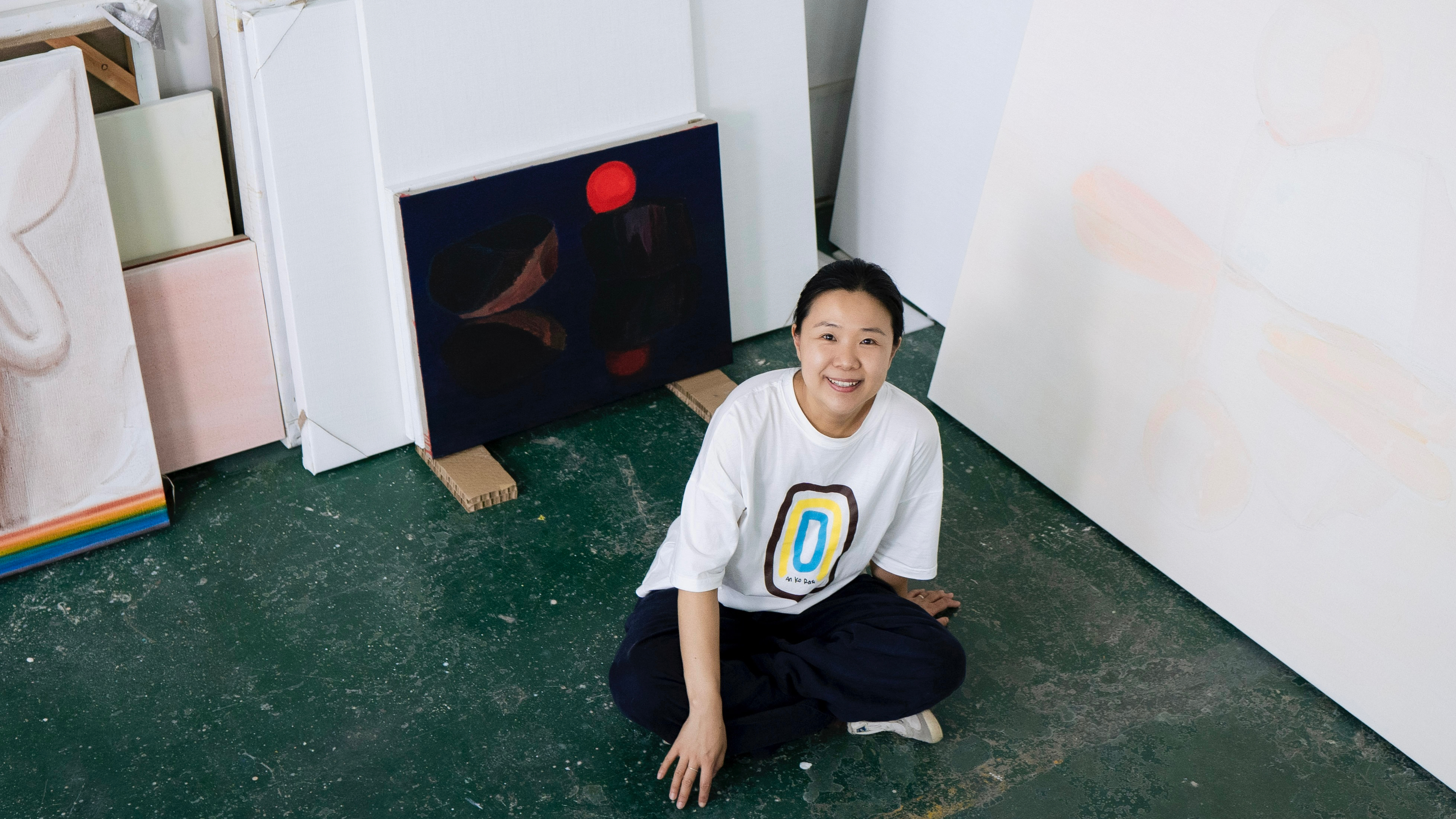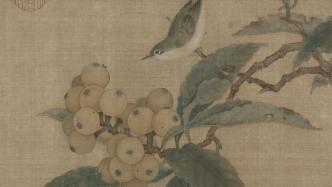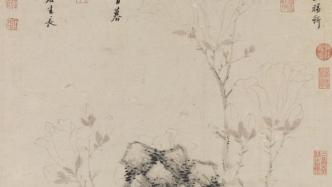
The Paper learned that on August 27, "Humanity and Realm - The Elegance in the Garden of Ancient Literati" was exhibited at the Liaoning Provincial Museum. The exhibition focuses on one of the most important creative motifs in Chinese traditional painting for more than a thousand years: "Garden and Mansion" paintings and related ancient paintings.
It is reported that in addition to 39 works from the Liaoning Museum's own collection, the exhibition also brings together 32 important collections from 8 well-known cultural and museum institutions in China, including the Palace Museum and Nanjing Museum, some of which are even domestic orphans. Including Liu Songnian's "Autumn Window Reading Easy Map" in the Southern Song Dynasty, "Zhuxi Thatched Cottage Map" in cooperation with Zhao Yong and Zhang Wo in the Yuan Dynasty, and "Dongzhuang Map Book" by Shen Zhou in the Ming Dynasty.
Among them, the first-class cultural relics such as Gong Xian's "Lakeside Grass Pavilion", Yun Shouping's "Fish and Algae", Tsinghuayan "Linjing" and other first-class cultural relics of the Qing Dynasty borrowed from the Jilin Provincial Museum were only displayed for 20 days; Ming Metabolism Ring "Apricot Garden Elegant Collection" is the first time in the past 20 years that this classic masterpiece in the history of Chinese painting has been loaned to an exhibition. 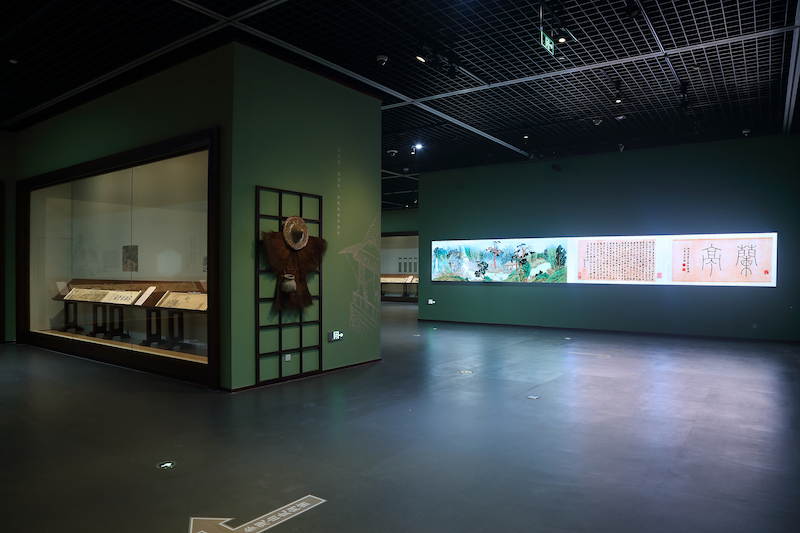
The exhibition site of "Humanity and Realm: The Elegance in the Garden of Ancient Literati"
Walking into the gate of the museum, a corner of the venue has quietly built white walls and black tiles, bamboo and stone windows, and misty water, just like a miniature version of Jiangnan garden scenery. "Building the garden" in the museum, "seeing the garden" in the painting. 
The exhibition site of "Humanity and Realm: The Elegance in the Garden of Ancient Literati"
"This exhibition focuses on one of the most important creative motifs in Chinese traditional painting for more than a thousand years: 'Garden and Mansion' paintings and related ancient paintings. The title of the exhibition 'Human·Jing' comes from the famous Tao Yuanming of the Eastern Jin Dynasty. Poems imply the idea of 'natural philosophy' of the harmony and unity of man and nature." Liu Yun, director of the exhibition planning department of Liaoning Provincial Museum, told The Paper that the exhibition is divided into "The Heart of Forest Spring", "Yayouyiyi" and "World in a Pot" "Poems and Paintings Reflecting Scenery" four divisions, including Ma Yuan, Xu Yugong, Wang Fu, Du Qiong, Shen Zhou, Zhou Chen, Wen Zhengming, Xia Chang, Tang Yin, Gong Xian, Xie Shichen, Wang Jian and other ancient painting "star masters" "Coffee" works also include paintings by famous painters who are good at expressing garden scenery. 
The exhibition site of "Humanity and Realm: The Elegance in the Garden of Ancient Literati"
"Apricot Garden" is the first loan exhibition in nearly 20 years
Ming Metabolism Ring "Apricot Garden Elegant Collection" depicts a gathering of literati. The painting depicts the gathering of officials Yang Rong, Yang Shiqi, Yang Pu and others in Yang Rong's apricot orchard, and the painter Xie Huan himself is also in it. The picture depicts three Yangs, six bachelors, fourteen servants and the artist himself. Collected by Zhenjiang Museum. 
Ming Xiehuan, "Apricot Garden Elegant Collection" (part) Zhenjiang Museum
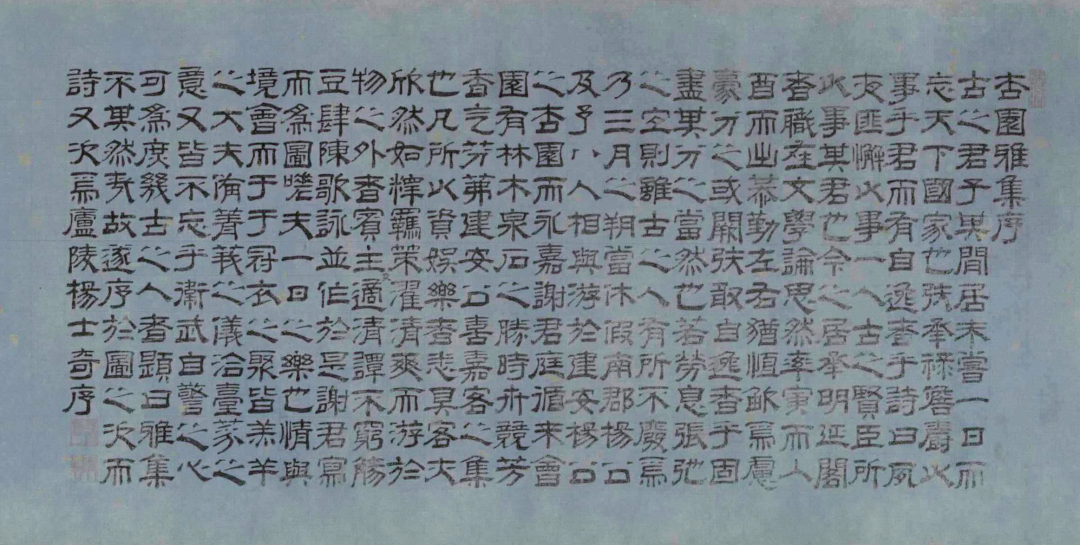
Yang Shiqi's Preface to the Collection of Apricot Gardens
The title of the volume is "Xingyuan Elegant Collection", hence the name. In the back of the volume, there is an official script of Yang Shiqi's "Xingyuan Elegant Collection"; Luling Yang Shiqi, Jian'an Yang Rong, Nanjun Yang Pu, Linchuan Wang Ying, Taihe Wang Zhi, Luling Zhoushu, Ancheng Li Shimian , Wenjiang Qian Xili, Tai and Chen Xun's poems on the spot; Yang Rong's "Xingyuan Elegant Collection Map" postscript; The poems and prose are 667 cm in length, and they are all mounted on the azure paper and lotus root paper. The whole volume has neither the author's signature nor the seal. 
Ming Xiehuan, "Apricot Garden Elegant Collection" (part) Zhenjiang Museum
Themes such as "Yajitu" seem to have formed a type since the creation of Song Dynasty painter Li Gonglin, and many painters have always painted themes based on this. Since it is called "Yaji", it must not be an ordinary gathering of relatives and friends, but a kind of poetry and prose activity that scholars and writers are keen to engage in. Everyone asked the painter to draw the people who participated in the meeting one by one as a commemoration. 
Ming Xiehuan, "Apricot Garden Elegant Collection" (part) Zhenjiang Museum
In this painting, the painter made a clever idea in the composition. In order to avoid the rigid composition of the uniform arrangement, he divided the painted figures into several groups. A group of elegant scholars gathered together to talk, talk eloquently, and looked relaxed and relaxed. Four elegant scholars walked back and forth, walking slowly to the side of the chess table, and some were walking alone, watching the scenery of the garden as they walked. The characters in the picture are neatly dressed, according to their order. Although everyone is close to a frontal portrait, their demeanor and posture are different, and they do their best. 
Ming Xiehuan, "Apricot Garden Elegant Collection" (part) Zhenjiang Museum
Some scholars believe that the fine workmanship of the whole brush, the rich colors, and the orderly layers can be seen from the painter's deep attainments in landscapes, figures, flowers and birds, and pavilions. The painting method of figures, trees and rocks evolved from Li Tang and Liu Songnian of the Southern Song Dynasty.
Some scholars also pointed out that this time, Yang Shiqi, Yang Shiqi, took advantage of Yang Rong's (Fujian) private garden, Xingyuan, and made an appointment with Yang Pu, and the holiday party was not held in the general sense of the court's civil servants, but with a A gathering of fellow villagers of the hidden color Jiangxi Civilian Group. Seven Jiangxi people and two non-Jiangxi cabinet ministers jointly held the Apricot Garden Gathering. The actual leader of the Jiangxi Civilian Group is Yang Shiqi. This painting highlights the regional characteristics of Ming politics at that time.
Ma Yuan, Shen Zhou and other ancient painting "stars" gathered
According to the introduction of the Liaoning Provincial Museum, the exhibition is divided into four parts: "The Heart of Linquan", "Yellow Travel", "The World in the Pot" and "Poems and Paintings".
The first part of the exhibits includes Liu Songnian's Autumn Window Reading Map from the Southern Song Dynasty, the Zhuxi Thatched Cottage Scroll of Cooperation by Zhao Yong and Zhang Wo in the Yuan Dynasty, the Dongzhuang Illustrated Scroll by Shen Zhou of the Ming Dynasty, Tang Yin's Wuyangzi Nurturing Scroll, Zhou Chen's "Chunquan Xiaoyin Scroll", Lan Ying's "Spring Pavilion Listening to the Spring", Qing Gong Xian's "Lakeside Grass Pavilion", Shi Tao's "Ancient Trees Overcast", Fan Qi's "Autumn Mountain Listening to Waterfalls" ", Lu Huancheng's "Spring Mountain Listening to Ruan's Chart Scroll", etc. 
Ming Dynasty, Zhoudongzhuang Tugengxi Xuan in the collection of Nanjing Museum
There are 24 original works of "Dongzhuang Atlas", of which only 21 survived after the end of the Ming Dynasty. It depicts the garden scene of the family of Wu Kuan, Shen Zhou's teacher. Wu Kuan was an official to the Minister of Rites. He was Shen Zhou's teacher and close friend, and he sang poetry and prose. Dongzhuang is the manor of Wu Kuan, and it is also a place where scholars from the south of the Yangtze River often gather, recite poetry and drink tea. Later generations praised Shen Zhou's "Dongzhuang Atlas", "Watching him enter and exit the Song and Yuan Dynasties, he feels at ease, the location is amazing, and the brushwork is complex, although the pictures of Li Longmian Mountain Villa and Hongyi Thatched Cottage are not much."
Dong Qichang wrote two inscriptions to this album:
Baishiweng wrote more than 20 pictures of Dongzhuang for Duke Wending of Wu. Yu Cong Wang Baigu heard about the Yao clan from Changxing in Tibet, and many people did not meet with the peace meeting. Now it is in the collection of Xiu Yu, so I have to read it, so as to accumulate thoughts about my life. Looking at his entry and exit in Song and Yuan Dynasties, he felt at ease, his location was fantastic, and his brushwork was complex. Although the pictures of Li Longmian Mountain Villa and Hongyi Thatched Cottage were not too many. Xiu Yu is a man of good old age, and he has collected ten pictures of the Hongyi Caotang, and now he has obtained it again. The good times are better than the sun, and the mind wanders in the meantime, He Xian sits in a hundred cities! Insufficient enjoyment, talk about a few words to begin with. Dong Qichang book, Ding Si (1617) March tenth and nine days.
Baishi Weng wrote the Dongzhuang map for Wu Wending. There were 24 original paintings, which were collected by Wen Xiucheng. They were lost due to the rise of officials. Later, Xiu Yu traced a thousand directions and got 21 paintings. Can't be seen. Xin You (1621) revisited Jingkou in August, so I will remember this for a visit. Dong Qichang. 
Ming Shen Zhou Dongzhuang Tuqu Pond (part), Nanjing Museum
After "Dongzhuang Tu" was scattered from Wu Kuan's family, it was successively collected by Wenjia, the Yao family in Changxing, Zhejiang, and Zhang Kunchen, a disciple of Jiangsu. It was collected and collected by Feng Zisheng, Pan Shicheng, Pan Yanling, Luo Tianchi, Wu Yuanhui, Pang Yuanji and others after Jiaqing.
During the period of the Republic of China, the album was owned by Pang Laichen, who is known as the first person in the contemporary Chinese painting and calligraphy collection. Now in the Nanjing Museum. 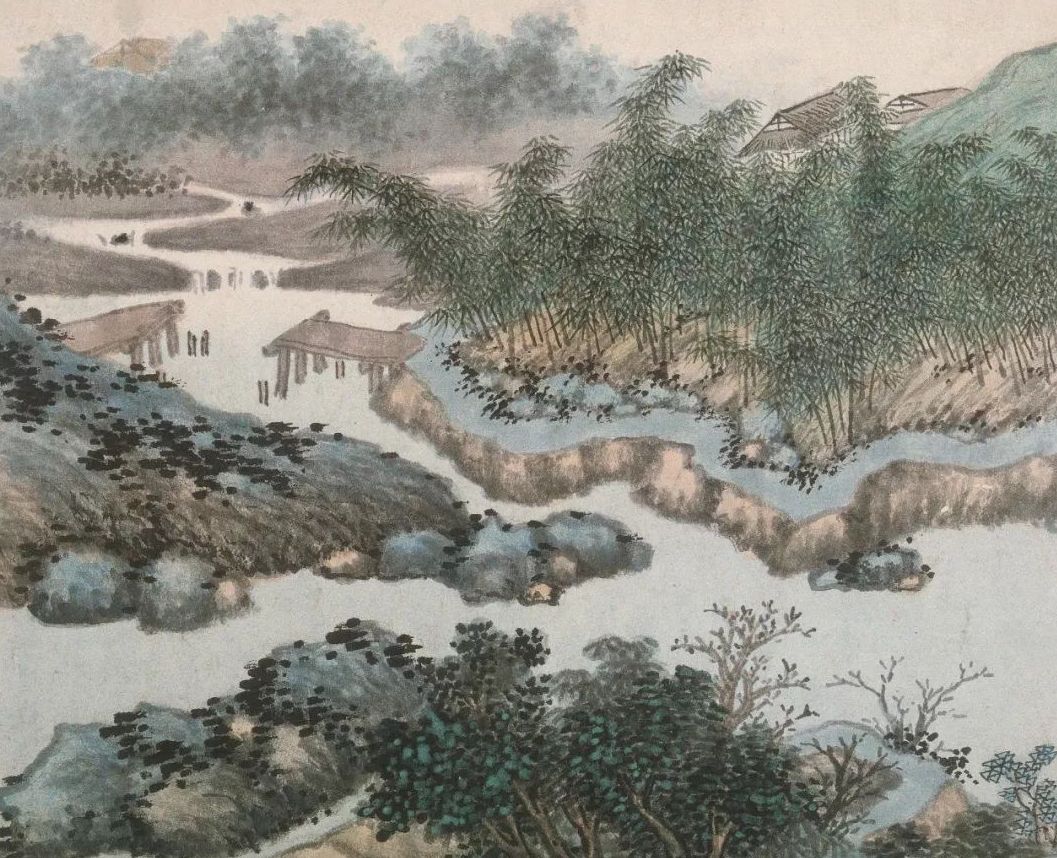
Ming Shen Zhou Dongzhuang Tu Xixi (part) Nanjing Museum collection
Due to repeated collections, three paintings of "Dongzhuang Tu" were lost at the end of the Ming Dynasty. The existing "Dongcheng", "Zhenyigang", "Zhegui Bridge", "Continued Ancient Hall", "Zhuo Xiu Nunnery" and "Gengxi Xuan" Twenty-one pieces including "Zhu Ying Path", "Quanzhen Pavilion" and "Chile Pavilion". There are three missing pieces. After Xiao Gu's field survey and verification in combination with many historical documents, he believes that they should be "Peach Blossom Pond", "Melon Garden" and "Guiwu". 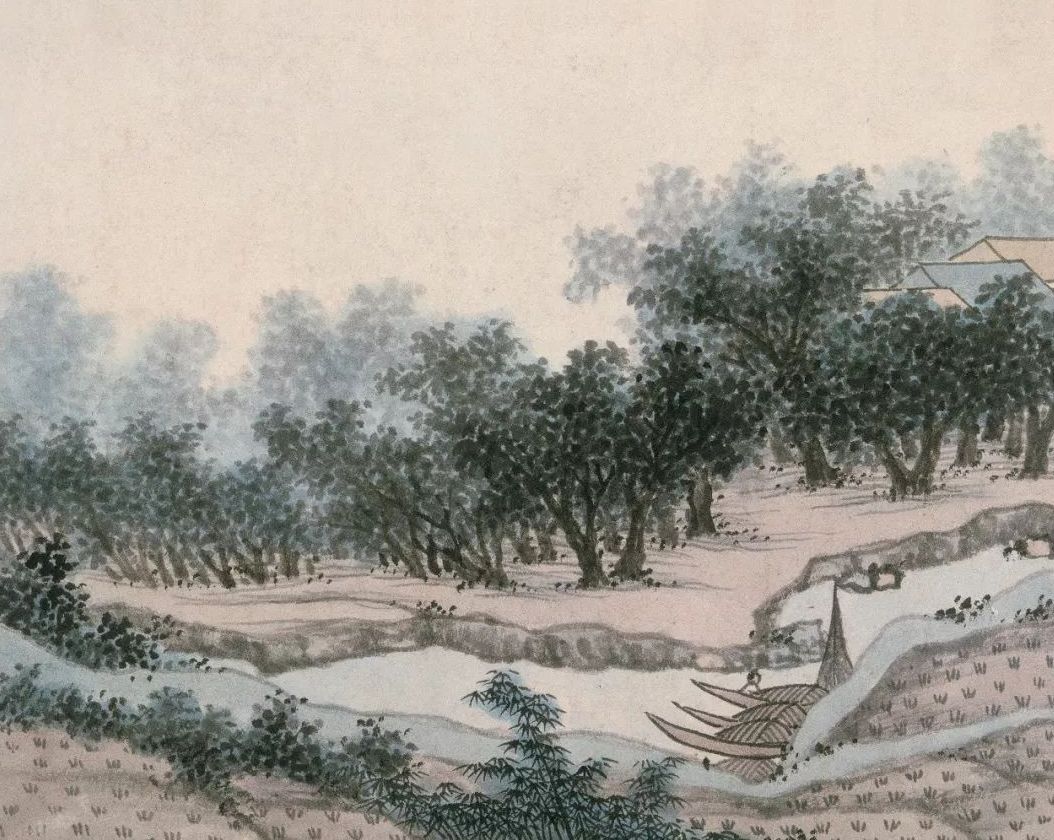
Ming Shen Zhou Dongzhuang Tunan Port (part), Nanjing Museum Collection
"Dongzhuang Tu" has a great influence on later garden paintings. Many garden paintings such as Wen Zhengming's "Humble Administrator's Garden", Shen Shichong's "Suburban Garden" and Zhang Hong's "Zhiyuan Tu" are all influenced by "Dongzhuang Tu". influences. 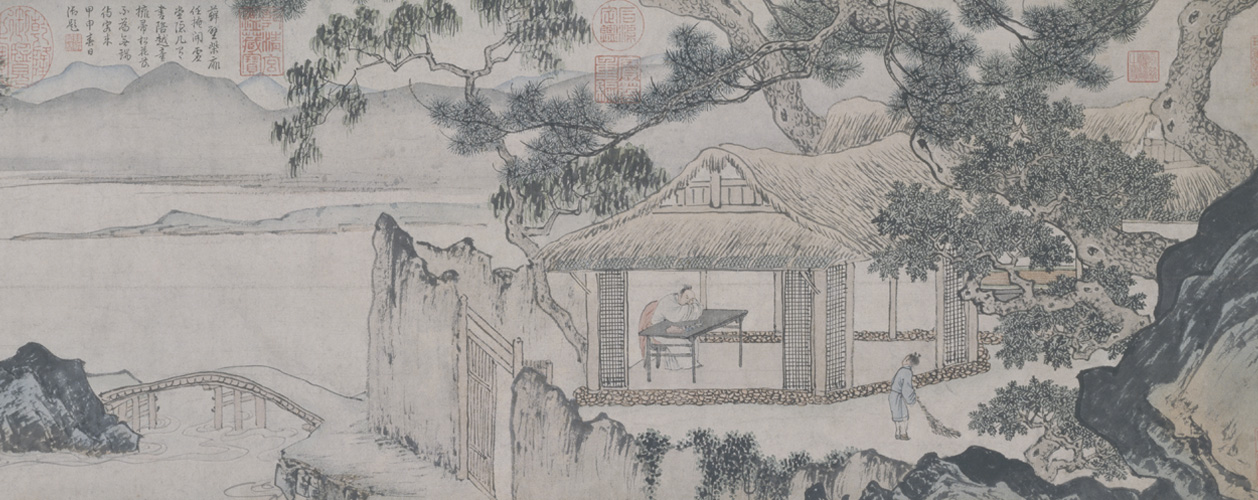
Ming Zhou Chen's "Chunquan Xiaoyin Picture Scroll" Collection of the Palace Museum
Zhou Chen's "Chunquan Xiaoyin Picture Scroll" is an alias map, which was made by Zhou Chen for a literati with the surname of Pei and the name Chunquan. The picture begins with Pei Jun's thatched cottage as the center. The owner is sleeping at the desk, and a boy outside the hall is cleaning with a broom, reflecting the fun of being leisurely and elegant. Afterwards, the Banqiao connected to the bank, the spring water gurgled, the green hills winding in the distance, and the flat lake was endless. In Chinese paintings, literati and hermits are often depicted sleeping during the day to show their indifference to the outside world, implying that they have different enjoyment from officials, and promoting the philosophy of self-liberation and self-consolation. The painter subtly highlights the close-up view of Banqiao and flowing water to show the meaning of "spring spring", and also uses sleepy sleep to express "little hidden" to point out the theme.
The artistic style of this work inherits the tradition of "academic style" painting in the Southern Song Dynasty. The brush of the trees and stones is strong and sharp, mostly chopped with small axes, and the ink is thick and moist, showing the painter's superb painting skills. 
Qing Dynasty Shitao ancient wood hanging shade chart in the collection of Liaoning Provincial Museum
Shi Tao's "Ancient Trees Overlooking the Shadow" axis, coloring and painting close-up layers of rocky and craggy, lush trees, winding mountain paths, hidden pavilions, distant mountains standing tall and straight, shrouded in clouds and smoke. The brush strokes are varied, and the colors are elegant and light. In the upper right corner is the author's long title.
Shi Tao (AD 1640~?), also named Dadizi and Bitter Gourd Monk, etc., descended from the Ming clan, commonly known as Zhu Ruoji, cut his hair and became a monk after the Qing Dynasty. Good at painting landscapes, he was one of the four painters in the early Qing Dynasty.
The works exhibited in the second part, "Yiyou Shiyi", include the anonymous "Paintings of the Nine Elders of Huichang" in the Northern Song Dynasty, Ma Yuan's "Pictures of Cups under the Moon" in the Southern Song Dynasty, Xiehuan's "Paintings of Elegant Collection in Apricot Garden" in the Ming Dynasty, and Shen Zhou's "Pen Chrysanthemums" Enjoying the Picture Scroll", Shen Zhou's "Weiyuan Elegant Collection Scroll", Qian Ku's "Jiaoting Meeting Chess Scroll", Chen Hongshou's "Douyao Scroll", Tsinghuayan's "Linjing Tu", etc. 
Ma Yuanyue in the Southern Song Dynasty
Among them, "Picture of Cups under the Moon" is a masterpiece handed down by Ma Yuan in the Southern Song Dynasty. Although it only opened the album, the picture is "small and medium-sized", and the brush and ink are quite vivid and refined. This composition seems to be flat, but in fact it is "dangerous in peace", showing the deep and dangerous atmosphere of the mountain stream. This picture depicts the beautiful night of the 15th Mid-Autumn Festival. A full moon hangs high in the sky, illuminating the sky and the earth so brightly. The host in the picture is light and elegant, with a cup in his hand to welcome friends, he seems so intimate and happy. There are four servants next to him, one waiting to be called, one serving fruit, and the other serving wine, looking back at the other half-hidden text boy who served the piano on the steps. Although the whole picture only depicts six masters and servants, it contains different styles of brush and ink, which is quite vivid and interesting. 
Ming Shen Zhou's "Graphic Scroll of the Elegant Collection of Wei Garden" in the collection of Liaoning Provincial Museum
In Shen Zhou's "Graphic Scroll of the Elegant Collection in Wei Garden", the painter created an atmosphere of a landscape pavilion and an elegant collection of forests and springs. The peaks and peaks in the distance rose steeply, lightly covered with mist. Near the top of the mountain and the middle of the mountainside, there are many terraces that rise slowly. There is a small bridge beside the stream, and the four people in the pavilion are sitting on the ground. Up and down the mountain, the vegetation is verdant, and the red maple leaves are dotted with fire, adding a bit of the beauty of the resort. 
Ming Shen Zhou's "Graphic Scroll of the Elegant Collection of Wei Garden" (part) Collection of Liaoning Provincial Museum
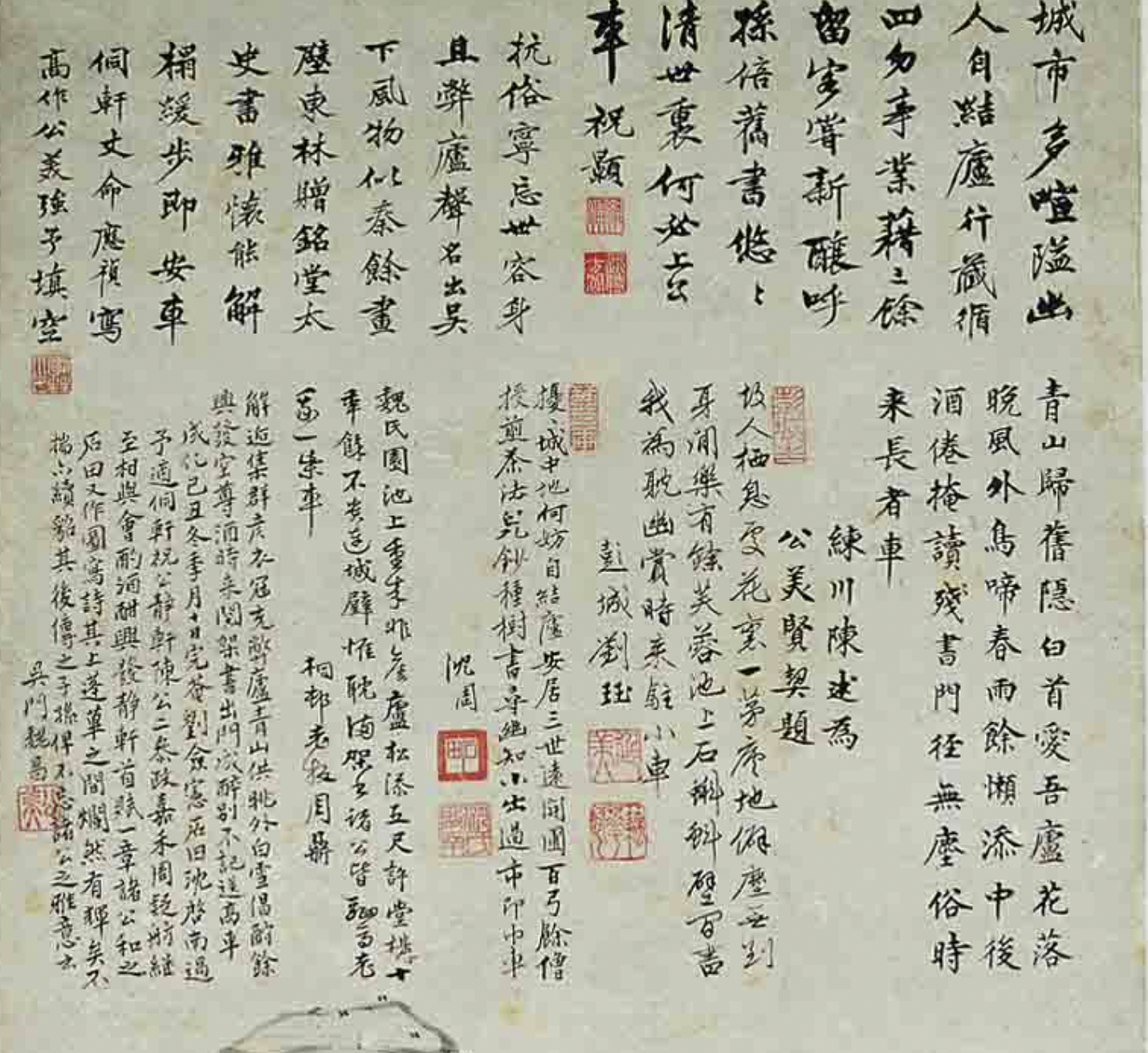
Ming Shen Zhou's "Graphic Scroll of the Elegant Collection of Wei Garden" (part) Collection of Liaoning Provincial Museum
At the top of the "A Collection of Weiyuan Gardens" there are poems and essays by Shen Zhou, Zhu Hao, Liu Jue, and Chen Chen. Zhu Hao's poem titled "The city is so noisy, the quiet people form their own cottages. Traveling and Tibetans follow the four nos, and borrowing more than three careers. Staying guests to taste new brews, calling Sunbei's old books. In the leisurely Qing world, why do you need to get on the bus?" Depicting natural scenery to convey the portrayal of oneself wanting to retreat to the mountains and live a leisurely rural life.
The works exhibited in the third part of "Heaven in the Pot" include the anonymous Southern Song Dynasty "Gumbo, Dog and Butterfly", Ming Luji's "Lion Head and Goose Scroll", Zhou Zhimian's "Plum Blossom Wild Pheasant Scroll", and Xu Wei's "Four Seasons Flower Scroll" , Qing Yun Shouping's "Fish and Algae Scroll", Jin Nong's "Miscellaneous Paintings Album", Ming Xiachang's "Qi'ao Qingfeng Scroll" and so on.
The fourth part, "Poems and Paintings Reflecting Scenery", exhibited Mingwen Zhengming's "Peach Garden and Jin Tu", Lu Zhi's "Poetic Landscapes of Tang and Song Dynasties", Xie Shichen's "Duling Poems", Wen Jia's "Chuihong Pavilion" Scroll, Wen Boren's Scroll of Stone Lake Thatched Cottage, Wang Jian's Scroll of Ten Scenes of Yushan, Qing Lu Huancheng's Scroll of Spring Night Banquet in Taoli Garden, Hua Yan's Scroll of Song Confucian Poems and Intentions. 
Ming Wen Zheng Ming Taoyuan Visits Jin Map Liaoning Provincial Museum Collection
Among them, "Peach Garden" is a full picture of distant mountains and hills, green and continuous, streams flowing across the river, lush trees, houses and village characters, hidden in the middle, there are old people sitting on the mountain road with sticks watching waterfalls and meditating, and women with young sticks at the gate of the courtyard fence Asking for directions, the four men in the house sat on the ground, drinking and talking. The thickness of the lines in the picture is full of changes, the ink color is dry and wet, and the layers are rich.
Wen Zhengming (1470-1559), first name Bi, one word Zhengzhong, No. Hengshan, was born in Changzhou (Suzhou), Jiangsu. He was the most famous painter and calligrapher in the mid-Ming Dynasty. In the history of painting, he is juxtaposed with Shen Zhou, Tang Yin and Qiu Ying, collectively known as the "Four Heroes of the Wu Family". Although he followed Shen Zhou, he still had his own style. He is multi-talented, capable of blue and green, ink painting, fine brushwork, and freehand brushwork. 
Ming Luzhi Tang Dynasty Poetic Landscape Album Collection of Suzhou Museum

Ming Xie Chen Du Ling's Poems Book Collection of the Palace Museum

Ming Wenboren Stone Lake Cottage Picture Scroll Collection of Suzhou Museum
Wen Boren's "Shihu Caotang Picture Scroll" painted the scenery of the Shihu Caotang at the foot of the Lengga Mountains, depicted Wang Chong's book, and encouraged his disciple Jin Yong to go to Beijing to take the test. This kind of painting method of integrating stories into landscapes is the specialty of the Wumen School of Painting. The brushwork is fine and sparse, and the colors are elegant and quaint. Knowing several paragraphs, the whole story of the picture is very detailed. The inscription "Jiajing Gui Chou (1553) Looking at the Queen in September", Wen Boren was fifty-two years old.
Wen Boren (1502-1575), courtesy name Decheng, was born in Wufeng Mountain, and was from Changzhou (now Suzhou, Jiangsu). Wen Zhengming's nephew. He is good at landscapes, figures, and can pass on family methods. He has a unique skill in writing and writing with Wang Meng. 
Qing Gongxian, Lakeside Grass Pavilion, Jilin Provincial Museum
Gong Xian's "Lakeside Grass Pavilion", the author depicts the scenery of Taihu Lake with a heavy brush. In the painting, there are dozens of miscellaneous trees on the soil slope in front of the painting, of different sizes, distances and distances, interspersed in density and density, and dyed with ink stains. The whole picture shows the beautiful scenery of Taihu Lake under the moonlight, and the artistic conception of the elegant collection of literati is vivid on the paper. Cranes are wheels."
Gong Xian (1618-1689), also known as Qixian, with the word Banqian, no. He spent most of his life in Nanjing. Gong Xian once studied painting in Dong Qichang when he was young, and he followed the theory of Dong's North-South Sect. His paintings are based on Dong Yuan of the Five Dynasties, with the painting methods of the Northern School in the early Song Dynasty as the main body, and the painting methods of Mi Fu, Shen Zhou and others, and finally formed his own appearance. Aged and elegant like Dong Yuan, it can be said that he is broad-minded and well-versed. 
Wang Jian's "Ten Scenes of Yushan Mountain" in the early Qing Dynasty, Suzhou Museum
At the beginning of the Qing Dynasty, Wang Jian's "Ten Scenes of Yushan Mountain" opened ten volumes, and he painted "The Return of the Sea", "Taoyuan Spring Stream", "Xicheng Pavilion", "Zhaoming Book Terrace", "Fushui Layers and Mountains", "Vima Treasure Tree" and "Lake Bridge Night" The ten scenic spots of the Moon, Wugu Danfeng, Yunhulong Temple, and Tengxi Snow. One open ink pen, two open green, seven open light purple. For the four seasons of spring, summer, autumn and winter, it adopts the styles of the Song and Yuan dynasties. The inscription is "Ren Zi (1672) Spring", when Wang Jian was sixty-four years old.
Wang Jian (1609-1677), courtesy name Yuanzhao, nicknamed Xiangbi, also known as the owner of Dyexiang Nunnery, was born in Taicang, Jiangsu. Wang Shizhen's grandson. In the sixth year of Chongzhen (1633), he was elected as the prefect of Lianzhou. He is good at painting landscapes, his brushwork is round and smooth, his brush is thick and smooth, and he imitates ancient times with great precision. He is as famous as Wang Shimin. Author of "Ranxiangan Collection".
At the end of the exhibition, Huang Yi's "Chongluo Visiting Monument Atlas" and Zhang Wei's "Lindun's New Residence No. 3". 
Qing Dynasty Huang Yi Chongluo Visiting Stele Atlas Collection of the Palace Museum

Qing Dynasty Huang Yi Chongluo Visiting Stele Atlas Collection of the Palace Museum
In front of Huang Yi's "Chongluo Visiting Stele Atlas", Sun Xingyan's seal script "Twenty-Four Pictures of Songluo Visiting Stele" was quoted and a poem was inscribed. There are inscriptions by Weng Fanggang on the folio, as well as inscriptions by Wang Niansun, Hong Fan, He Qi, Yi Bingshou, and Dong Shixi. On the back paper, there are eight inscriptions by Liang Tongshu, Xi Gang, Song Baochun, Xu Shangzhi, Wang Bingtao, Chen Gong, He Shaoji (two), and Qi Junzao.
"Songluo Visiting Stele" is the scene and place where Huang Yi painted the stele he searched, and it is a record of field investigation. There are: Dengci Temple, Xuanyuan, Dajue Temple, Songyang Academy, Zhongyue Temple, Shaoshi Shique, Kaiyuan Temple, Taihang Autumn, Shaolin Temple, Shicong, Kaimu Shique, Huishan Temple, Baima Temple, Songyue Temple , Yique, Longmen Mountain, Fragrant Mountain, Fengxian Temple, Mang Mountain, Laojun Cave, Pingping Temple, Jingshan, Jinbei, and Xiaoshishan houses twenty-four. The painter opens the title of each title, opens the title and annotates it. With light ink and dry brush to highlight the scenery, the composition is simple and light and scattered, with a sense of coldness and ease, and it feels ancient in the lightness.  It is reported that the exhibition is sponsored by Liaoning Provincial Culture and Performing Arts Group (Liaoning Provincial Public Cultural Service Center), undertaken by Liaoning Provincial Museum and Beijing Painting Academy, and supported by the Palace Museum, Nanjing Museum, Zhejiang Provincial Museum, Tianjin Museum, Jilin Provincial Museum, Suzhou Museum, Zhenjiang Museum and Lushun Museum. The exhibition will run until October 16.
It is reported that the exhibition is sponsored by Liaoning Provincial Culture and Performing Arts Group (Liaoning Provincial Public Cultural Service Center), undertaken by Liaoning Provincial Museum and Beijing Painting Academy, and supported by the Palace Museum, Nanjing Museum, Zhejiang Provincial Museum, Tianjin Museum, Jilin Provincial Museum, Suzhou Museum, Zhenjiang Museum and Lushun Museum. The exhibition will run until October 16.
Attachment: Exhibition Catalogue of "Humanity and Environment - The Garden of Elegance of Ancient Literati"
The first part of Lin Quan's heart
Unit 1 Heart Traces
Ming Lan Yingchun Pavilion Listening to the Spring Scroll Collection of Liaoning Provincial Museum
Qing Dynasty Gong Xian Lakeside Grass Pavilion Scroll Collection of Jilin Provincial Museum
Qing Dynasty Shitao ancient wood hanging shade chart in the collection of Liaoning Provincial Museum
Qing Dynasty Wu Hongjiang Building Visiting Friends Scroll Collection of Lushun Museum
Qing Dynasty Fan Qi Qiushan Listening to Waterfall Chart Scroll Collection of Lushun Museum
Qing Dynasty, Jinkun, Crane Scroll in Gushan, Zhejiang Provincial Museum
Qing Dynasty, Lv Huancheng's Scroll of Listening to Ruan in Chunshan Mountain, in the collection of Lushun Museum
Qing Dynasty Wu Li Nanyue Pine Cloud Map Scroll Collection of Liaoning Provincial Museum
Qing Dynasty, Dai Xixutang's Lezhi Chart Scroll Collection of Liaoning Provincial Museum
Qing Yexin Landscape Atlas Collection of Lushun Museum
Unit 2 The Mind
Southern Song Dynasty, Liu Songnian, Autumn Window Reading Easy Map Page Collection of Liaoning Provincial Museum
Southern Song Dynasty, Zhao Daheng, Weiting Resting Picture Page Collection of Liaoning Provincial Museum
Southern Song Dynasty, Anonymous, Yulou Chunsi map page Collection of Liaoning Provincial Museum
Southern Song Dynasty Anonymous Jiangting Range Rover Map Page Collection of Liaoning Provincial Museum
Yuan Zhao Yong, Zhang Wo, Zhuxi Thatched Cottage, Collection of Liaoning Provincial Museum
Ming Zhou Chen, Chunquan Xiaoyin, Collection of the Palace Museum
Tang Yin, Ming Dynasty, Wuyangzi's Nurturing Picture Scroll Collection of Liaoning Provincial Museum
Ming Shen Zhou Dongzhuang Atlas Collection of Nanjing Museum
Qing Dynasty Yuzhi Ding, Lan Shen Yunlin Coherence Scroll Collection of Zhejiang Provincial Museum
Tsinghua Scroll of Yanchuli in the collection of Liaoning Provincial Museum
The second part of elegant travel
Unit 1 Elegant Tour
Northern Song Dynasty Anonymous Huichang Jiu Lao Picture Scroll Collection of Liaoning Provincial Museum
Ming Xiehuan Apricot Garden Elegant Collection Scroll Collection of Zhenjiang Museum
Ming Shen Zhou Pen Chrysanthemum Appreciation Scroll Collection of Liaoning Provincial Museum
Ming Dynasty, Shenzhou and Weiyuan's elegant collection, collection of Liaoning Provincial Museum
Qing Dynasty Zhang Bolong Ancient Pine Flowing Spring, Volume Collection of Liaoning Provincial Museum
Tsinghua Guanxi Garden Revisited Picture Scroll Collection of Liaoning Provincial Museum
Ming Dynasty Wang Jian Hutian Cave Music Scroll Collection of Zhejiang Provincial Museum
Unit 2 Exciting
Southern Song Dynasty Ma Yuanyue's Cup Picture Page Collection of Tianjin Museum
Ming Zhu Tian Yucheng Erda's Pleasure Scroll Collection of Zhejiang Provincial Museum
Ming Shen Zhen, Bamboo Furnace Mountain House Chart Scroll Collection of Liaoning Provincial Museum
Ming Qian Ku, Jiaoting chess chart scroll, collection of Liaoning Provincial Museum
Qing Shangrui Visiting Friends with the Qin, Collection of Lushun Museum
Qing Dynasty, You Shao, Xi Gang, Zhang Xun, etc. Pleasure Scroll in the Rose Garden Collection of Liaoning Provincial Museum
unit 3 boudoir
Southern Song Dynasty, Anonymous, Washing Hands and Viewing Flowers, Collection of Tianjin Museum
Chen Hongshou, Ming Dynasty, a sketch scroll of a bucket, collected by the Liaoning Provincial Museum
Ming Anonymous, Imitation of Qiuying Han Palace Spring Dawn, Collection of Liaoning Provincial Museum
Qing Dynasty Reformed Qi Liu Yin Yiqu Picture Scroll Collection of Lushun Museum
Qing Leng Mei Tuo Axis Collection of Lushun Museum
Tsinghua Rock Proximity Map Collection of Jilin Provincial Museum
The third part of the world in the pot
Unit 1 Spiritual
Southern Song Dynasty, Anonymous, Okra, Dog and Butterfly Picture Page Collection of Liaoning Provincial Museum
Lvji of Ming Dynasty, Scroll with Lion Head and Goose, Collection of Liaoning Provincial Museum
Crown of Ming and Zhou Dynasties Plum Blossom Wild Pheasant Chart Axis Collection of Liaoning Provincial Museum
Ming Xu Wei, Four Seasons Flowers, Collection of Jilin Provincial Museum
Ming Wang Guxiang Flower Atlas Collection of Liaoning Provincial Museum
Qing Dynasty, Yun Shouping, Fish and Algae Chart Scroll Collection of Jilin Provincial Museum
Qing Dynasty, Shen Quan, Guihe Scroll, Collection of Liaoning Provincial Museum
Qing Jinnong Miscellaneous Paintings Collection Liaoning Provincial Museum
Unit 2 Gentleman
Southern Song Dynasty, Xu Yugong, Plum and Bamboo in Snow, Collection of Liaoning Provincial Museum
Ming Wenzheng Ming Yilan, Bamboo and Stone Scroll Collection of Liaoning Provincial Museum
Ming Xia Chang, Qi'ao Qingfeng Scroll, Collection of Tianjin Museum
Yuan Li Shixing, Bamboo and Stone Scroll, Collection of Liaoning Provincial Museum
Qingxu Valley Chrysanthemum Chart Scroll Collection of Liaoning Provincial Museum
Qing Zhuda, Pine, Cypress, Tongchun, Scroll, Collection of Liaoning Provincial Museum
Qing Luopin, Plum, Orchid, Bamboo and Stone Scroll Collection of Liaoning Provincial Museum
Part 4 Poetry and painting scenes
Unit 1 Dreams
Yuan Anonymous Lotus Boat Crescent Scroll Collection of Liaoning Provincial Museum
Ming Luzhi, Tang and Song Dynasties, Poetic Landscape Atlas, Collection of Suzhou Museum
Ming Dynasty Xie Shichen Du Ling's Poems Book Collection of the Palace Museum
Ming Wen Zhengming's Taoyuan Visiting Jin Scroll Collection of Liaoning Provincial Museum
Qing Dynasty, Lu Xue's Peach Blossom Source, in the collection of Zhejiang Provincial Museum
Qing Dynasty, Song Xu, Drunkard Pavilion, Liaoning Provincial Museum
Qing Dynasty Lu Huancheng's Spring Night Banquet in Taoli Garden Collection of Lushun Museum
Tsinghua Rock, Song Confucian Poetry Intentional Scroll, Collection of Suzhou Museum
Unit 2 Purpose
Ming Wang Fu, Hushan Bookstore, Collection of Liaoning Provincial Museum
Ming Wenjia, Chuihong Pavilion, Collection of Suzhou Museum
Ming Wenboren Stone Lake Cottage Picture Scroll Collection of Suzhou Museum
Ming Zhang Hong, Xishan Fresh Air Scroll Collection of Zhejiang Provincial Museum
In the late Ming and early Qing dynasties, Wang Jian's Atlas of Ten Scenes of Mount Yu, in the collection of Suzhou Museum
Qing Dynasty Huang Yi Chongluo Visiting Stele Atlas Collection of the Palace Museum
Qing Zhang Li, Lindun's New Residence, Volume 3, Collection of Suzhou Museum
